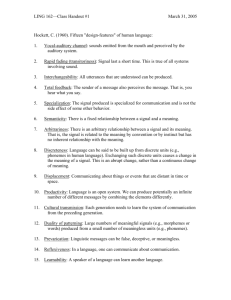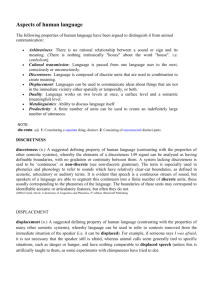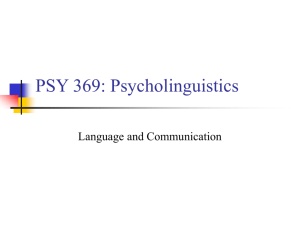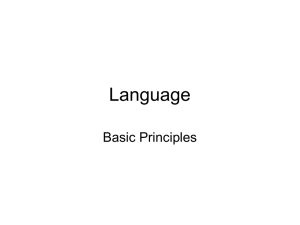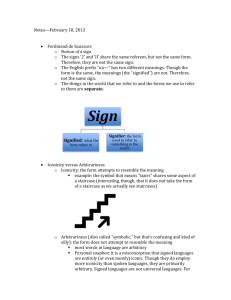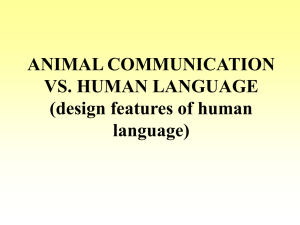öğrenci kuzu bügün
advertisement
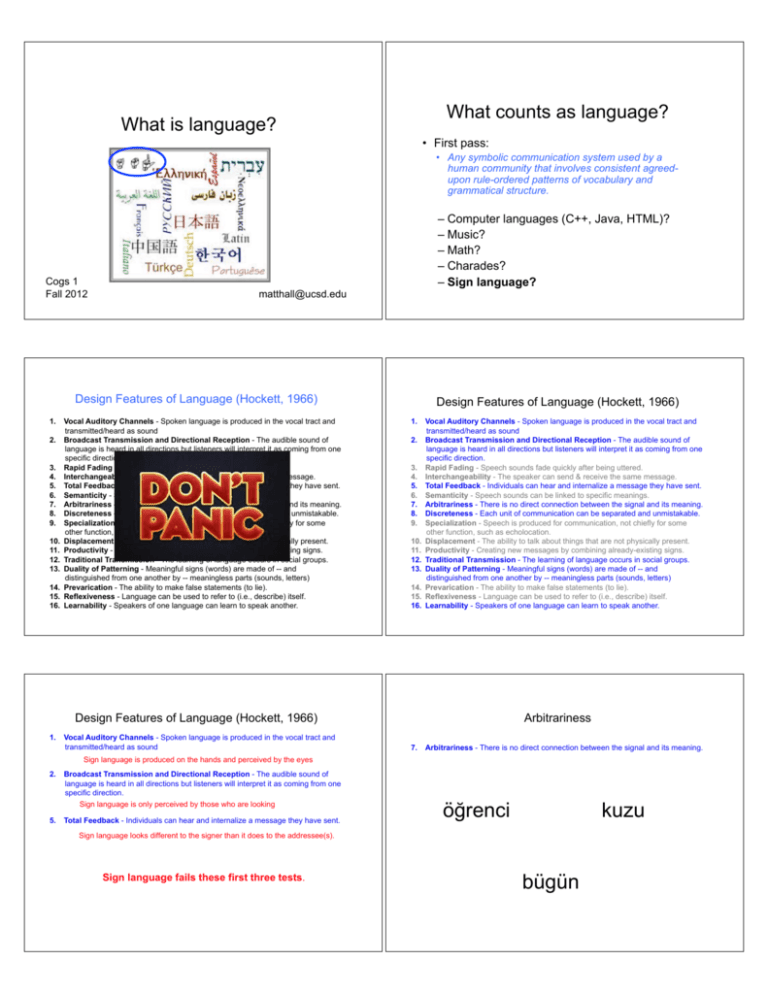
What counts as language? What is language? •! First pass: •! Any symbolic communication system used by a human community that involves consistent agreedupon rule-ordered patterns of vocabulary and grammatical structure. Cogs 1 Fall 2012 –! Computer languages (C++, Java, HTML)? –! Music? –! Math? –! Charades? –! Sign language? matthall@ucsd.edu Design Features of Language (Hockett, 1966) 1.! 2.! 3.! 4.! 5.! 6.! 7.! 8.! 9.! 10.! 11.! 12.! 13.! 14.! 15.! 16.! Vocal Auditory Channels - Spoken language is produced in the vocal tract and transmitted/heard as sound Broadcast Transmission and Directional Reception - The audible sound of language is heard in all directions but listeners will interpret it as coming from one specific direction. Rapid Fading - Speech sounds fade quickly after being uttered. Interchangeability - The speaker can send & receive the same message. Total Feedback - Individuals can hear and internalize a message they have sent. Semanticity - Speech sounds can be linked to specific meanings. Arbitrariness - There is no direct connection between the signal and its meaning. Discreteness - Each unit of communication can be separated and unmistakable. Specialization - Speech is produced for communication, not chiefly for some other function, such as echolocation. Displacement - The ability to talk about things that are not physically present. Productivity - Creating new messages by combining already-existing signs. Traditional Transmission - The learning of language occurs in social groups. Duality of Patterning - Meaningful signs (words) are made of -- and distinguished from one another by -- meaningless parts (sounds, letters) Prevarication - The ability to make false statements (to lie). Reflexiveness - Language can be used to refer to (i.e., describe) itself. Learnability - Speakers of one language can learn to speak another. Design Features of Language (Hockett, 1966) 1.! 2.! 3.! 4.! 5.! 6.! 7.! 8.! 9.! 10.! 11.! 12.! 13.! 14.! 15.! 16.! Vocal Auditory Channels - Spoken language is produced in the vocal tract and transmitted/heard as sound Broadcast Transmission and Directional Reception - The audible sound of language is heard in all directions but listeners will interpret it as coming from one specific direction. Rapid Fading - Speech sounds fade quickly after being uttered. Interchangeability - The speaker can send & receive the same message. Total Feedback - Individuals can hear and internalize a message they have sent. Semanticity - Speech sounds can be linked to specific meanings. Arbitrariness - There is no direct connection between the signal and its meaning. Discreteness - Each unit of communication can be separated and unmistakable. Specialization - Speech is produced for communication, not chiefly for some other function, such as echolocation. Displacement - The ability to talk about things that are not physically present. Productivity - Creating new messages by combining already-existing signs. Traditional Transmission - The learning of language occurs in social groups. Duality of Patterning - Meaningful signs (words) are made of -- and distinguished from one another by -- meaningless parts (sounds, letters) Prevarication - The ability to make false statements (to lie). Reflexiveness - Language can be used to refer to (i.e., describe) itself. Learnability - Speakers of one language can learn to speak another. Design Features of Language (Hockett, 1966) 1.! Vocal Auditory Channels - Spoken language is produced in the vocal tract and transmitted/heard as sound Arbitrariness 7.! Arbitrariness - There is no direct connection between the signal and its meaning. Sign language is produced on the hands and perceived by the eyes 2.! 3.! 4.! 5.! Broadcast Transmission and Directional Reception - The audible sound of language is heard in all directions but listeners will interpret it as coming from one specific direction. Rapid Fading - Speech sounds fade by quickly uttered. Sign language is only perceived thoseafter whobeing are looking Interchangeability - The speaker can send & receive the same message. Total Feedback - Individuals can hear and internalize a message they have sent. ö!renci kuzu Sign language looks different to the signer than it does to the addressee(s). Sign language fails these first three tests. bügün Arbitrariness 7.! Arbitrariness - There is no direct connection between the signal and its meaning. Arbitrariness 7. Arbitrariness - There is no direct connection between the signal and its meaning. Iconicity: some non-arbitrary connection between the signal and its meaning. (SCISSORS, FLUTE, HAMMER) Iconicity in spoken languages: onomatopoeia English: “bang”, “drip drop”, “woof” Greek: “gkoup”, “plits plits”, “gav” Korean: “koong”, “toktok”, “meong” Arbitrariness 7.! Arbitrariness - There is no direct connection between the signal and its meaning. Arbitrariness 7. Arbitrariness - There is no direct connection between the signal and its meaning. Iconicity plays a role in sign, but also in speech. Crucially, sign languages do use lots of arbitrary structure! Sign language PASSES the arbitrariness test. Iconicity in sign languages: TREE American Sign Language Chinese Sign Language Danish Sign Language Arbitrariness across sign languages: ASL vs. BSL WHAT = WHERE, MEANING = ORGANIZE, CORRECT = TALK Discreteness 8. Discreteness - Each unit of communication can be separated and unmistakable. Discreteness 8. Discreteness - Each unit of communication can be separated and unmistakable. Problematic! Words are sequential; signs are simultaneous. •! How many sounds in: –! stop –! oboe –! six •! Words in all spoken languages are built out of these bits of sound, called phonemes. Is it possible to break a single sign down into units? Handshape: RED vs. CUTE Movement: IMPOSSIBLE vs. NEW YORK STATE Location: ONION vs. KEY Orientation: SOCK vs. STAR Sign language PASSES the discreteness test. Duality of Patterning Duality of Patterning 13. Duality of Patterning - Meaningful signs (words) are made of -- and distinguished from one another by -- meaningless parts (sounds, letters) 13. Duality of Patterning - Meaningful signs (words) are made of -- and distinguished from one another by -- meaningless parts (sounds, letters) “hope” “wish” “desire” – similar meanings, but different sounds “cat” “act” “tack” - words with the same sounds don’t share the same meaning. Do signs that share phonological parameters share meaning? Handshapes: RED, ETC, DREAM, UGLY CUTE, BACON, HURRICANE, FUNNY Movements: CHAIR, IMPOSSIBLE, UMBRELLA, NAME. TEMPORARY, SUBWAY, NEW YORK, ERASE Locations: ONION, ANNOYING, NEPHEW, LETTUCE. KEY, MEDICINE, BUTTER, RAKE So meaningless sub-lexical units combine to form signs- good. Is there structure at any more complex level? English: verb + “(at)ion” = noun locate + ion = location suspend + ion = suspension prepare + ation = preparation ASL: verb + repeated movement = noun EAT + repeated movement = FOOD SIT + repeated movement = CHAIR CALL + repeated movement = PHONE Sign language PASSES the duality of patterning test. Orientations: BOOK, THING, BOAT, NEW PAPER, CHEESE, MOVIE, SCHOOL Learnability 16. Learnability - Speakers of one language can learn to speak another. Corollary: The system must be learnable by human infants! Is sign language acquisition like spoken language acquisition? babbling 1st sign multiple sign utterances Traditional Transmission How sign language acquired? -parents?? -schools -teachers -peers Native (10%) Non-native (90%) Because sign language is (1) not inborn, and (2) acquired in social groups from other humans, sign language PASSES the Traditional Transmission test. Sign language PASSES the learnability test. What about the other 90%? Native (10%) •! Homesign •! Emerging sign languages •! Cochlear implants Non-native (90%) Homesign •! How would we know if language were inborn? –! Linguistic isolation: highly unethical but tragically common –! Deaf kids typically have nurturing families •! Without input, deaf children create communicative systems –! Semanticity, Displacement, Productivity –! Duality of Patterning, Discreteness, Arbitrariness Emerging Sign Languages Can homesigners learn language later? •! Critical period •! What happens when a bunch of homesigners get together? –! Learning a sign language –! Learning to read/write school (ISN) Rachel Mayberry, UCSD Linguistics family (ZFHS) community (ABSL) Cochlear Implants Emerging Sign Languages •! Each successive generation adds new linguistic structure. –! Learners go beyond their input •! Language structure is not built from the bottom up, but from the center out. •! Challenges clear-cut distinctions between “Language” and not-language. •! Convert acoustic energy (sound waves) into electrical signals, bypassing cochlea •! Sound like this: •! http://www.sens.com/helps/demo05/helps_d05a_demo_blank.htm •! Adult-onset deafness is easily treated with a CI •! Imagine trying to learn a language from that noisy input. Cochlear Implants 2-year-olds Ava (BSL) Kennedy (hearing) comprehension Speech outcomes 6mos – 8yrs production Cooper (CI) Cochlear Implants Learnability 16. Learnability - Speakers of one language can learn to speak another. Corollary: The system must be learnable by human infants! Recap: what we’ve learned 1.! 2.! Children with CIs need years of intensive speech therapy to acquire spoken language. Most have no other language to rely on. Speech FAILS this test for deaf kids with cochlear implants. Acquisition of speech with CIs requires effortful instruction 3.! 4.! 5.! 6.! 7.! 8.! 9.! 10.! 11.! 12.! 13.! 14.! 15.! 16.! How does sign language stack up? •! Sign languages are full, natural human languages. •! Sign languages help us reconsider what human languages are truly like, and provide new insight into where they come from. •! Understanding the full communicative power of sign has important implications for medical and educational policy. •! E-mail me any time if you have more questions: matthall@ucsd.edu Vocal Auditory Channels - Spoken language is produced in the vocal tract and transmitted/heard as sound Broadcast Transmission and Directional Reception - The audible sound of language is heard in all directions but listeners will interpret it as coming from one specific direction. Rapid Fading - Speech sounds fade quickly after being uttered. Interchangeability - The speaker can send & receive the same message. Total Feedback - Individuals can hear and internalize a message they have sent. Semanticity - Speech sounds can be linked to specific meanings. Arbitrariness - There is no direct connection between the signal and its meaning. Discreteness - Each unit of communication can be separated and unmistakable. Specialization - Speech is produced for communication, not chiefly for some other function, such as echolocation. Displacement - The ability to talk about things that are not physically present. Productivity - Creating new messages by combining already-existing signs. Traditional Transmission - The learning of language occurs in social groups. Duality of Patterning - Meaningful signs (words) are made of -- and distinguished from one another by -- meaningless parts (sounds, letters) Prevarication - The ability to make false statements (to lie). Reflexiveness - Language can be used to refer to (i.e., describe) itself. Learnability - Speakers of one language can learn to speak another.
